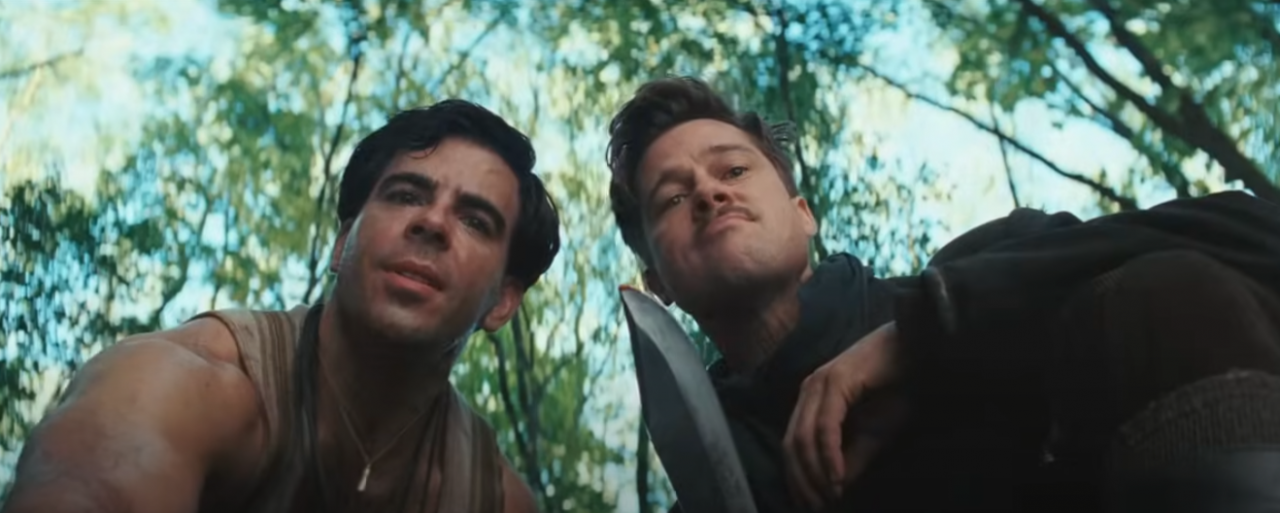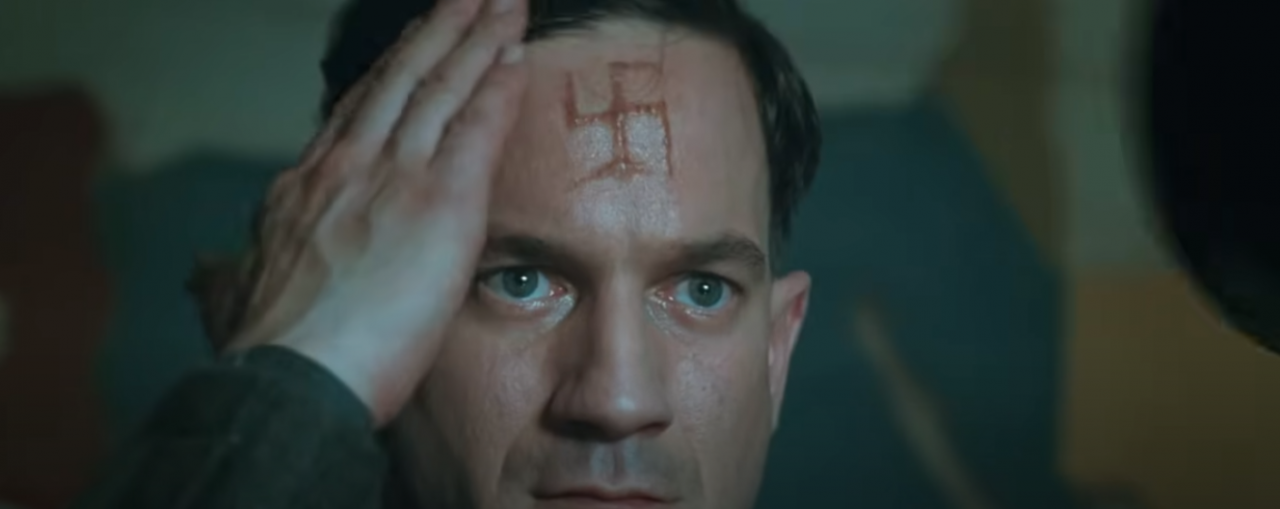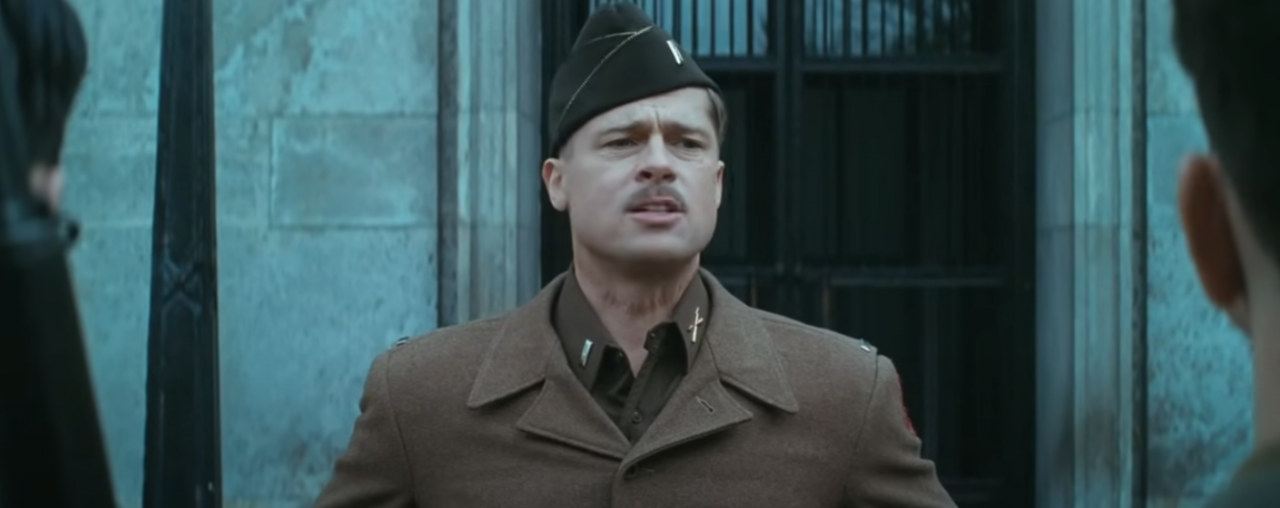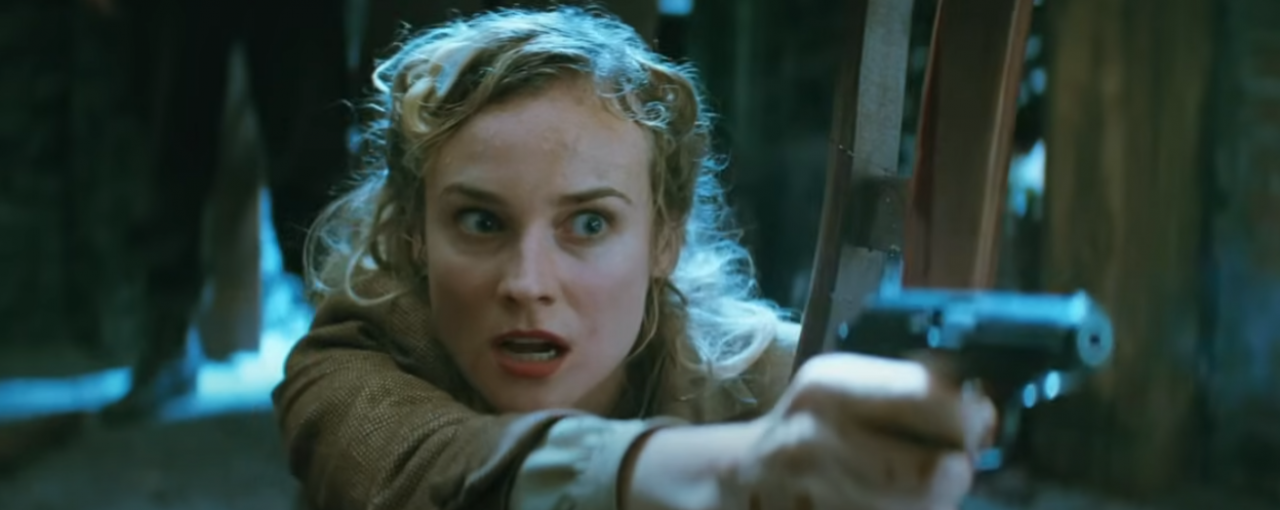Recap

The film unfolds in Nazi-occupied France and follows two primary, eventually intersecting, plots to assassinate high-ranking Nazi officials, including Adolf Hitler himself.
The first narrative thread introduces us to the titular “Basterds,” a commando unit of eight Jewish-American soldiers led by the charismatic and ruthless Lieutenant Aldo Raine (Brad Pitt), aka “Aldo the Apache.” Their mission is simple and brutal: to instill terror in the hearts of German soldiers by killing and scalping them. Raine, a man of few words but decisive, violent action, famously demands “100 Nazi scalps” from each of his men.

Their exploits become legendary, striking fear into the German ranks. One of their signature moves is to spare one German soldier from each ambushed group, carving a swastika into their forehead so they can never hide their past.

Parallel to this, we meet Shosanna Dreyfus (Mélanie Laurent), a young Jewish woman who narrowly escapes the horrific murder of her family at the hands of the chillingly intelligent and sadistic SS Colonel Hans Landa (Christoph Waltz), known as the “Jew Hunter.” Years later, Shosanna is living in Paris under an assumed identity, Emmanuelle Mimieux, and owns a cinema. Fate takes a dark turn when a German war hero, Fredrick Zoller (Daniel Brühl), who is also the star of a new Nazi propaganda film, “Nation’s Pride,” becomes infatuated with her. He convinces Joseph Goebbels to hold the film’s premiere at Shosanna’s theater, an event that will be attended by the highest echelons of the Nazi party, including Hitler, Goebbels, and Hermann Göring. For Shosanna, this presents an unmissable opportunity for a spectacular and deeply personal revenge. She plans to burn down the theater with the Nazi leadership trapped inside, using her highly flammable nitrate film collection.

The Basterds, meanwhile, learn of the premiere through a British intelligence operation involving a German film star and double agent, Bridget von Hammersmark (Diane Kruger). After a disastrous rendezvous in a basement tavern that leaves most of the British team and several Basterds dead, Raine and the remaining members team up with von Hammersmark to infiltrate the premiere. Their plan involves posing as Italian filmmakers accompanying von Hammersmark.
Character Analysis
Colonel Hans Landa (Christoph Waltz): Arguably the film’s most captivating and terrifying character. Landa is the personification of intelligent evil. Multilingual, charming, and impeccably mannered, he uses his sharp intellect and powers of deduction not for justice, but for sadistic sport and personal gain. He’s a master manipulator, relishing the psychological torment of his victims. Waltz’s Oscar-winning performance is a tour-de-force, making Landa one of cinema’s most memorable villains. His opportunism and lack of true ideological conviction (beyond self-preservation and advancement) make him uniquely dangerous.
Lieutenant Aldo Raine (Brad Pitt): The stoic, neck-scarred leader of the Basterds. Raine is a man of simple, brutal convictions. His folksy Tennessee drawl and seemingly unrefined demeanor mask a cunning and unyielding determination to punish Nazis. He is less about sophisticated strategy and more about visceral impact. Pitt imbues him with a larger-than-life, almost mythical quality, a righteous fury given human (and terrifyingly effective) form. Shosanna Dreyfus/Emmanuelle Mimieux (Mélanie Laurent): The avenging angel of the film. Shosanna’s transformation from a terrified survivor to a cold, calculating instrument of vengeance is central to the film’s emotional core. Laurent portrays her with a quiet intensity, her grief and rage simmering beneath a carefully constructed facade. Her plot is meticulous and deeply personal, a cinematic retribution for cinematic propaganda.
Bridget von Hammersmark (Diane Kruger): The glamorous German film star secretly working for the Allies. She is intelligent and brave but also caught in the dangerous game of espionage. Her interactions with both the Basterds and Landa highlight the precariousness of her position and the high stakes involved.
Fredrick Zoller (Daniel Brühl): The German war hero whose infatuation with Shosanna unwittingly sets the stage for the film’s climax. Zoller represents a more complex Nazi figure – a celebrated killer who also craves affection and artistic recognition, yet remains blind to the true nature of Shosanna’s feelings and the horror he represents to her.
Ending Explained
During the screening of “Nation’s Pride,” Zoller, still obsessed with Shosanna, confronts her in the projection booth. She initially rejects him, then shoots him. Thinking him dead, she briefly shows a flicker of remorse, only for Zoller to fatally shoot her before succumbing to his own wounds. However, Shosanna’s plan is already in motion. A pre-recorded film segment featuring her face appears on the cinema screen, defiantly announcing to the Nazi audience that they are about to be killed by a Jew. Her loyal projectionist and lover, Marcel, ignites a massive pile of nitrate film behind the screen, and the theater quickly becomes an inferno as he has locked the auditorium doors.
Inside the auditorium, two of the Basterds, Donny “The Bear Jew” Donowitz (Eli Roth) and Omar Ulmer (Omar Doom), who managed to get seated near Hitler’s box, unleash a hail of machine-gun fire, riddling both Hitler and Goebbels with bullets. They then continue to fire into the panicked crowd until the timed explosives they planted earlier detonate, ensuring no Nazi leader escapes.
Unbeknownst to the Basterds executing the attack inside, Colonel Landa, who had astutely deduced the Basterds’ (and von Hammersmark’s) plot, captures Lt. Raine and another Basterd, Smithson Utivich. However, instead of stopping the assassination, Landa, ever the opportunist, strikes a deal with Raine’s OSS commanders via radio.

He allows the assassination to proceed in exchange for safe passage to American lines, a full pardon, American citizenship, and various benefits. As Landa and Raine drive into Allied territory, Landa gleefully believes he has outsmarted everyone. However, Raine, true to his word that no Nazi under his watch gets off that easily, orders Landa out of the vehicle. While he honors the “deal” made by his superiors (not killing Landa), he takes out his knife and carves a swastika into Landa’s forehead, ensuring that even in freedom, Landa will forever be marked as a Nazi. Raine looks at his handiwork on the screaming Landa and declares to Utivich, “Y’know somethin’, Utivich? I think this just might be my masterpiece.”
The ending signifies a complete rewriting of history, where the primary architects of the Holocaust are brutally and decisively eliminated not by grand armies or political maneuvering, but by the visceral revenge of their victims and a band of vengeful soldiers. Landa’s fate underscores the film’s theme of indelible marks – both physical and psychological, left by war and ideology. Raine’s final act is his ultimate “artistic” statement on the Nazi regime.
Analysis
Revenge and Justice: This is the most prominent theme. The film offers a cathartic, albeit fictional, retribution for the atrocities of the Nazi regime. It questions whether eye-for-an-eye justice can ever be truly satisfying or morally sound, even as it revels in its execution.
The Power of Cinema and Propaganda: Film itself plays a crucial role within the narrative. Nazi propaganda (“Nation’s Pride”) is a tool of the regime, while Shosanna uses her cinema and film as a weapon of mass destruction and a medium for her final, defiant message. Tarantino knowingly winks at the audience, highlighting cinema’s ability to shape narratives, history, and even reality.
Performance and Identity: Many characters are engaged in elaborate performances – Shosanna’s assumed identity, the Basterds’ attempts to pass as Italians, Landa’s charming facade. The film explores how identities are constructed, concealed, and violently stripped away.
Moral Ambiguity: While the Nazis are unequivocally evil, the “heroes” themselves operate in morally grey areas. The Basterds’ methods are savage, and Raine’s final act, while viscerally satisfying to some, is a form of mutilation. The film delights in blurring the lines between hero and anti-hero.
History as Malleable Narrative: Tarantino boldly discards historical accuracy to craft a story that serves his thematic and entertainment purposes. It posits history not as a fixed set of facts, but as a story that can be retold and reshaped, especially through the lens of popular culture.
Is Inglourious Basterds Based on Real Life Story?
While “Inglourious Basterds” is a work of fiction, it draws loose inspiration from several real-life elements:
- The Title: The title itself is a deliberate misspelling and homage to Enzo G. Castellari’s 1978 Italian war film, “The Inglorious Bastards.”
- Special Operations Units: The concept of a specialized commando unit operating behind enemy lines is based on real Allied units like the British Special Operations Executive (SOE) and the American Office of Strategic Services (OSS). There were indeed Jewish soldiers who undertook dangerous missions against the Nazis, some driven by a desire for revenge or to rescue family. One such unit was X-Troop, a British unit composed mainly of German-speaking Jewish refugees who conducted commando raids and intelligence gathering.
- Nazi Hunters: While Colonel Landa is fictional, the relentless pursuit of Nazi war criminals after the war by individuals and organizations is a historical fact.
- Fredrick Zoller’s Inspirations: The character of Fredrick Zoller, the German sniper hero, is reportedly inspired by real-life highly decorated soldiers like Audie Murphy (American) and Matthäus Hetzenauer (Austrian sniper), whose battlefield exploits were sometimes used for propaganda purposes.
However, Tarantino takes these inspirations and weaves them into a narrative that is entirely his own, prioritizing cinematic impact and thematic resonance over historical fidelity. The assassination of Hitler in a Parisian cinema in 1944 is pure, unadulterated historical revisionism.
Review
IMDb: The film holds a high rating of 8.4/10 based on over 1.7 million user ratings. User reviews frequently praise Christoph Waltz’s performance as one of the greatest villains in cinema history, the sharp dialogue, suspenseful scenes, and Tarantino’s signature stylized violence and storytelling. Many consider it one of his best films, highlighting its entertainment value and thought-provoking themes.
Rotten Tomatoes: The film boasts an 89% “Certified Fresh” score on the Tomatometer, based on 336 critic reviews. The critics’ consensus reads: “A classic Tarantino genre-blending thrill ride, Inglourious Basterds is violent, unrestrained, and thoroughly entertaining.” The Audience Score is similarly high at 88% from over 250,000 ratings. Critics lauded its audacious rewriting of history, stellar performances (particularly Waltz), and Tarantino’s confident direction, even if some found its tonal shifts and historical liberties challenging.
The film isn’t built around a conventional payoff but rather around tension, character performances, and thematic irony.
Tarantino structures the film almost like a novel, in chapters, with intersecting but loosely connected arcs. This nonlinear storytelling, while rich in character moments (like Shosanna’s arc), can feel disjointed if you’re expecting a tightly interwoven plot or traditional climax/resolution for each character.
Many of Tarantino’s films leave characters dead or plans unfulfilled. It’s his way of saying: life is messy, violent, and rarely just. Shosanna’s end is tragic and abrupt, but it mirrors the brutality and senselessness of war. If you were hoping for poetic justice, Tarantino instead gives you explosive irony.
Final Verdict
In conclusion, “Inglourious Basterds” is a bold, provocative, and immensely entertaining film that solidifies Quentin Tarantino’s status as a master of postmodern cinema. It’s a war film, a revenge thriller, a dark comedy, and a love letter to the power of movies, all rolled into one unforgettable package. It’s a film that sparks debate, elicits strong reactions, and, much like Aldo Raine’s final handiwork, leaves an indelible mark.




